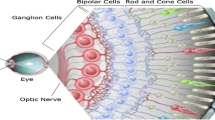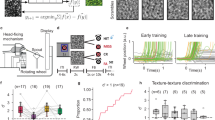Abstract
Grating cells were discovered in the V1 and V2 areas of the monkey visual cortex by von der Heydt et al. (1992). These cells responded vigorously to grating patterns of appropriate orientation and periodicity. Computational models inspired by these findings were used as texture operator (Kruzinga and Petkov 1995, 1999; Petkov and Kruzinga 1997) and for the emergence and self-organization of grating cells (Brunner et al. 1998; Bauer et al. 1999). The aim of this paper is to create a grating cell operator  that demonstrates similar responses to monkey grating cells by applying operator
that demonstrates similar responses to monkey grating cells by applying operator  to the same stimuli as in the experiments carried out by von der Heydt et al. (1992). Operator
to the same stimuli as in the experiments carried out by von der Heydt et al. (1992). Operator  will be tested on images that contain periodic patterns as suggested by De Valois (1988). In order to learn more about the role of grating cells in natural vision, operator
will be tested on images that contain periodic patterns as suggested by De Valois (1988). In order to learn more about the role of grating cells in natural vision, operator  is applied to 338 real-world images of textures obtained from three different databases. The results suggest that grating cells respond strongly to regular alternating periodic patterns of a certain orientation. Such patterns are common in images of human-made structures, like buildings, fabrics, and tiles, and to regular natural periodic patterns, which are relatively rare in nature.
is applied to 338 real-world images of textures obtained from three different databases. The results suggest that grating cells respond strongly to regular alternating periodic patterns of a certain orientation. Such patterns are common in images of human-made structures, like buildings, fabrics, and tiles, and to regular natural periodic patterns, which are relatively rare in nature.
Similar content being viewed by others
References
Albrecht D, De Valois RL, Thorell L (1980) Visual cortical neurons: are bars or gratings the optimal stimuli? Science 207:88–90
Andrews BW, Pollen DA (1979) Relationship between spatial frequency selectivity and receptive field profile of simple cells. J Physiol 287:163–176
Bauer C, Burger T, Lang EW (1999) A neural network model for the self-organization of cortical grating cells. In: Mira J, Sánchez-Andrés JV (eds) Foundations and tools for neural modeling. Proceedings of international work-conference on artificial and natural neural networks (IWANN’99), vol I. Alicante, 2–4 June 1999. Lecture notes in computer science, vol 1606. Springer, Berlin Heidelberg New York, pp 431–441
Brunner K, Kussinger M, Stetter M, Lang EW (1998) A neural network model for the emergence of grating cells. Biol Cybern 78:389–397
Daugman JG (1985) Uncertainty relation for resolution in space, spatial frequency, and orientation optimized by two-dimensional visual cortical filters. J Opt Soc Am 2(7):1160–1169
De Valois RL, Albrecht D, Thorell L (1978) Cortical cells: bar and edge detectors, or spatial frequency filters. In: Cool S, III ES (eds) Frontiers of visual Science. Springer, Berlin Heidelberg New York
De Valois KK, De Valois RL, Yund E (1979) Responses of striate cortical cells to grating and checkerboard patterns. J Physiol Lond 291:483–505
De Valois RL, De Valois KK (1988) Spatial vision. Oxford University Press, Oxford
Engel S, Zhang X, Wandell B (1997) Colour tuning in human visual cortex measured with functional magnetic resonance imaging. Nature 388:68–71
Gegenfurther KR, Kiper DC, Fenstemaker SB (1996) Processing of color, form, and motion in macaque area v2. Vis Neurosci 13:161–172
Hubel D, Wiesel T (1962) Receptive fields, binocular interaction, and functional architecture in the cat’s visual cortex. J Physiol Lond 160:106–154
Hubel D, Wiesel T (1974) Sequence regularity and geometry of orientation columns in the monkey striate cortex. J Comp Neurol 154:106–154
Jones J, Palmer L (1987) An evaluation of the two-dimensional gabor filter model of simple receptive fields in cat striate cortex. J Neurophysiol 58:1233–1258
Kaplan E, Shapley RM (1986) The primate retina contains two types of ganglion cells, with high and low contrast sensitivity. Proc Natl Acad Sci USA 83:2755–2757
Kruizinga P, Petkov N (1995) A computational model of periodic-pattern-selective cells. In: Mira J, Sandoval F (eds) Proceedings of the international workshop on artificial neural networks (IWANN’95). Lecture notes in computer science, vol 930. Springer Berlin Heidelberg New York, pp 90–99
Kruizinga P, Petkov N (1999) Nonlinear operator for oriented texture. IEEE Trans Image Process 8(10):1395–1407
Livingstone MS, Hubel DH (1984) Anatomy and physiology of a color system in the primate visual cortex. J Neurosci 4:309–356
Lourens T (1998) A biologically plausible model for corner-based object recognition from color images. Shaker, Maastricht
Lourens T, Barakova EI, Tsujino H (2003) Interacting modalities through functional brain modeling. In: Mira J, Álvarez JR (eds) Proceedings of the international work-conference on artificial and natural neural networks (IWANN’03). Lecture notes in computer science, vol 2686, Springer, Berlin Heidelberg New York, pp 102–109
Morrone MC, Burr DC (1988) Feature detection in human vision: a phase-dependent energy model. Proc R Soc Lond 235:335–354
Movshon JA, Thompson ID, Tolhurst DJ (1978) Receptive field organization of complex cells in the cat’s striate cortex. J Physiol 283:53–77
Petkov N, Kruizinga P (1997) Computational models of visual neurons specialised in the detection of periodic and aperiodic oriented visual stimuli: bar and grating cells. Biol Cybern 76(2):83–96
Tamura H, Sato H, Katsuyama N, Hata Y, Tsumoto T (1996) Less segregated processing of visual information in v2 than in v1 of the monkey visual cortex. Eur J Neurosci 8:300–309
von der Heydt R (1987) Approaches to visual cortical function. In: Reviews of physiology biochemistry and pharmacology, vol 108. Springer, Berlin Heidelberg New York, pp 69–150
von der Heydt R, Peterhans E, Dürsteler MR (1991) Grating cells in monkey visual cortex: coding texture? Visual cortex. In: Blum B (ed) Channels in the visual nervous system: neurophysiology, psychophysics and models. Freund, London, pp 53–73
von der Heydt R, Peterhans E, Dürsteler MR (1992) Periodic-pattern-selective cells in monkey visual cortex. J Neurosci 12(4):1416–1434
Würtz RP, Lourens T (2000) Corner detection in color images through a multiscale combination of end-stopped cortical cells. Image Vis Comput 18(6–7):531–541
Zeki S (1993) A vision of the brain. Blackwell, London
Author information
Authors and Affiliations
Corresponding author
Rights and permissions
About this article
Cite this article
Lourens, T., Barakova, E., Okuno, H. et al. A computational model of monkey cortical grating cells. Biol Cybern 92, 61–70 (2005). https://doi.org/10.1007/s00422-004-0522-2
Received:
Accepted:
Published:
Issue Date:
DOI: https://doi.org/10.1007/s00422-004-0522-2




